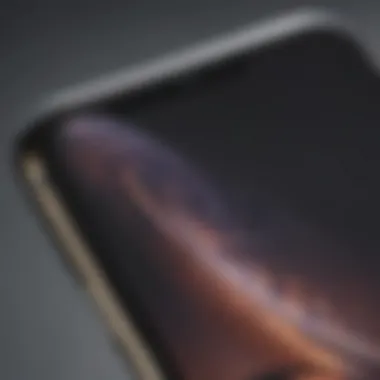Understanding iPhone XR Connectivity: Is It 5G Ready?


Intro
In the rapidly advancing world of mobile technology, the connectivity capability of devices is often a pivotal aspect for users. As 5G networks become increasingly prevalent, the inquiry of whether the iPhone XR supports this next-generation technology emerges. This guide endeavors to unravel the connectivity features of the iPhone XR through a detailed lens, aiming to clarify its position in the expansive landscape of mobile communications.
Product Overview
Foreword to the Apple Product Being Discussed
The iPhone XR, released in October 2018, serves as a significant player in Apple's extensive lineup of smartphones. Positioned as a more budget-friendly option compared to its contemporaries, such as the iPhone XS and XS Max, the iPhone XR attracted considerable attention for its blend of performance, design, and value.
Key Features and Specifications
When considering the iPhone XR, it is essential to note several key specifications:
- Display: A 6.1-inch Liquid Retina LCD with a resolution of 1792 x 828 pixels.
- Chipset: A12 Bionic chip, known for its powerful performance and efficiency.
- Camera: A single 12-megapixel rear camera with Smart HDR capabilities and a 7-megapixel front camera.
- Battery Life: It's renowned for its impressive battery longevity, capable of lasting up to 25 hours on a single charge in talk time.
These elements illustrate a balance of functionality, catering to both everyday users and tech enthusiasts.
Design and Aesthetics
In terms of design, the iPhone XR presents a streamlined silhouette. Its notable color palette, ranging from coral to black, satisfies various aesthetic preferences. The use of aluminum and glass in its construction not only offers a premium feel but also speaks to Apple's commitment to quality and craftsmanship.
Performance and User Experience
Performance Benchmarks
The performance of the iPhone XR claims the crown in many areas, boasting its A12 Bionic chip. Benchmarked against similar devices from the same era, its performance remains competitive, primarily in graphics and processing tasks.
User Interface and Software Capabilities
Users interact with iOS, which provides a smooth interface. Increased functionalities in features such as Face ID and seamless integration with Apple's ecosystem enhance usability enormously. The device supports iOS updates, allowing users to benefit from improved features and security upgrades.
User Experiences and Feedback
Feedback from users consistently highlights the balance of performance and battery life. Many commend its usability, especially within settings reliant on inefficient mobile data connections, despite the absence of 5G.
Comparison with Previous Models or Competitors
Advancements and Improvements from Previous Models
In comparing the iPhone XR with prior models, the most apparent improvement lies in battery efficiency and display technology. The upgrade to the A12 chip brought better graphics and faster processing compared to the A11 previously utilized in the iPhone 8.
Competitive Analysis with Other Similar Products
When juxtaposed with contemporaries like the Google Pixel 3 and the Samsung Galaxy S10, the iPhone XR stands its ground. While lacking in 5G capabilities, it excels at efficiency and build quality.
Value Proposition
The iPhone XR embodies a justification for its pricing strategy, presenting a unique intersection of features and affordability, absent in many high-end alternatives.
Tips and Tricks
How-to Guides and Tutorials for Optimizing the Apple Product's Performance
For iPhone XR users seeking to maximize productivity, periodic updates ensure optimal performance. Managing background apps and tailoring the iOS accessibility feature can enhance overall user experience significantly.
Hidden Features and Functionalities
Users may benefit from features like Screen Time, enhancing app utilization awareness. Moreover, automating routines using Shortcuts can enrich daily activities effectively.
Troubleshooting Common Issues


In instances of connectivity problems, restarting the device occasionally resolves minor hiccups. Keeping track of terms such as network settings reset can assist users in managing ongoing issues.
Latest Updates and News
Recent Developments in Software Updates and New Features
Apple periodically enhances the iPhone XR's software, with updates to iOS consistently unfolding new features. These updates have introduced functionalities that boost user engagement, despite Back-to-Back updates likely refraining from a shift to 5G capabilities.
Industry News and Rumors Surrounding Upcoming Products
There exists constant speculation regarding future iPhone releases and their anticipated 5G prowess, advancing contentions between existing model capabilities and upcoming enhancements.
Events and Announcements from Apple
Recent announcements reflect Apple’s ongoing initiatives focused on integrating robust technologies across their product spectrum while also maintaining legacy device oversight.
For further insights on mobile technology advancements, refer to resources like Wikipedia or Britannica.
Prologue to iPhone XR
The iPhone XR holds a unique position in Apple's lineup, combining advanced technology with a more affordable price. Understanding this model is essential for both potential buyers and existing users, especially as mobile connectivity standards continue to evolve. This section delves into the iPhone XR’s characteristics and its initial market reception, providing context to the ongoing discussions around its capabilities, specifically in relation to 5G.
Overview of the iPhone XR
The iPhone XR was launched in October 2018. It was widely marketed for its impressive features and relative affordability compared to its peers. This smartphone is equipped with a 6.1-inch Liquid Retina display, powered by Apple’s A12 Bionic chip. Its design includes a singular rear camera, which still delivers high-quality images. The model supports Face ID for unlocking and enhanced security.
Unlike the more premium iPhone XS and XS Max, the XR does not feature OLED technology but it compensates with longer battery life and vibrant color options. Customers appreciated the balance between price and performance, making it a popular choice during its release.
Launch and Reception
iPhone XR faced a mixed response at launch. Analysts were initially cautious, questioning its potential success within a saturated market. However, sales figures demonstrated unexpected popularity, particularly among younger consumers. For many, it served as a pathway into the iOS ecosystem without the steep price tag of flagship models.
Reviews noted positives such as battery life, camera performance, and software experience. Despite its limitations, such as the display quality considered lesser compared to OLED screens, many found the phone to meet everyday requirements effectively. This range of responses highlights the importance of examining such models within the broader context of technological advancements and consumer expectations, providing insights into how connectivity standards evolve.
Mobile Connectivity Standards
Mobile connectivity standards are crucial to understanding the capabilities of devices like the iPhone XR. They define the protocols and technologies that enable communication over cellular networks. As mobile technology has advanced, these standards have evolved from the initial 2G networks to the current discussions about 5G connectivity. Recognizing these developments is significant for consumers who wish to optimize their experience.
In this section, we will focus on the elements of mobile connectivity, highlighting the benefits and considerations:
- Infrastructure Requirement: Each standard requires different infrastructures. 4G LTE and 5G infrastructure relies on tall towers and small cell sites to manage data flow and coverage area.
- Speed and Efficiency: Higher standards promise improved speeds. While 4G LTE can deliver download speeds of up to 100 Mbps, 5G technology theoretically allows for multi-gigabit speeds, drastically reducing latency.
- Device Compatibility: Not every device can connect to every network. Knowing which devices support which standards will help consumers make informed purchase decisions. In the case of iPhone XR, it lacks 5G compatibility, which may influence future investment choices for users.
- Geographical Variability: Not all regions have the same coverage quality. Urban settings tend to offer better service than rural ones due to the concentration of towers and infrastructure.
Understanding mobile connectivity standards aids consumers and tech enthusiasts in knowing what capabilities to expect from their devices.
Understanding 4G LTE
4G LTE, introduced in the late 2000s, is a foundational standard allowing smartphone users to experience enhanced mobile Internet. LTE stands for Long Term Evolution and represents a significant leap forward from its predecessor, 3G.
Key features of 4G LTE include:
- Enhanced Data Rates: Downloads can reach speeds of 100 Mbps while stationary and up to 50 Mbps in localized environments like moving vehicles.
- Lower Latency: This standard drastically reduces response times compared to previous generations, improving usability for real-time applications such as video calls and gaming.
- Improved Voice Quality: VoLTE (Voice over LTE) enables crisper voice calls on the same data network, providing a seamless communication experience.
For iPhone XR users, 4G LTE connectivity supports daily usage, including browsing, streaming, and simultaneous calls while using data.
Prologue to 5G Technology
With the introduction of 5G technology, the quest for faster and more efficient connectivity has taken a new turn. 5G, meaning fifth generation, presents enhancements not feasible with prior standards.
Some essential aspects of 5G include:
- Significantly Greater Speeds: The theoretical maximum speeds for 5G can reach 10 Gbps, enabling instantaneous downloads and smoother streaming experiences.
- Diverse Applications: 5G's architecture supports innovations like autonomous vehicles, smart cities, and enhanced augmented reality experiences for users across various sectors.
- Increased Device Density: 5G has the potential to connect millions of devices per square kilometer, enhancing Internet of Things (IoT) capabilities.


These technological advances will influence the future landscape of connectivity, making it essential for consumers to explore how the ongoing developments may overshadow the less-capable models like iPhone XR.
Understanding the underlying technology can empower consumers to make informed choices, further enriching their mobile experiences.
Connectivity Features of iPhone XR
Understanding the connectivity features of the iPhone XR is vital for both current users and prospective buyers. This section covers its capabilities and limitations while exploring how it compares to other models in Apple's lineup. The ability to connect to various networks is significant in today's mobile world, where speed and reliability play a crucial role in user experience. The iPhone XR leverages 4G LTE, which remains a standard for many users, but it also presents certain limitations when discussing its future-proofing concerning 5G technology. Overall, this section delves deeper into the specifications that define this device’s performance in the realm of connectivity.
Supported Network Bands
The iPhone XR supports several network bands that facilitate connections across multiple geographic f areas. This broad compatibility allows users to enjoy stable connections not only in urban settings but also in rural ones.
- GSM: Supports bands 1, 2, 3, 4, 5, 8.
- CDMA: Compatible bands include 0, 1, 10, and additional carriers-operating bands.
This range is notable for ensuring that users can access various networks, be it AT&T, T-Mobile, or Verizon. Through its capabilities, the iPhone XR maintains strong signal quality, which contributes to overall satisfaction in browsing, calling, or texting. Additionally, the ability to switch seamlessly between networks can be an asset for those who frequently travel.
Comparison with Other iPhone Models
The connectivity aspect extends also to comparative analysis with other models like the iPhone XS, iPhone XS Max, and iPhone 11 series. Evaluating these differences provides insight into how the iPhone XR fits into the evolving tech landscape.
iPhone XS and iPhone XS Max
Both the iPhone XS and iPhone XS Max present advancements in mobile connectivity features. They support more extensive LTE bands and have enhanced antenna configurations, which improves signal reception and battery life during data-heavy tasks. The notable characteristic of these devices is their incorporation of improved modem technology, promoting faster download and upload speeds during operation. This trait makes them popular choices among users who heavily rely on their mobile devices for professional or recreational uses.
The special advantage of iPhone XS and XS Max comes down to their 5G readiness. While the XS line lacks 5G capabilities at launch, they incorporate systems that can facilitate a smoother transition when networks upgrade, especially as software evolves.
iPhone Series
In contrast, the iPhone 11 series — including the iPhone 11, 11 Pro, and 11 Pro Max — offers extended features like improved modem chips allowing users to connect to diverse bands more efficiently. One significant aspect of the iPhone 11 series is the strengthened 4G LTE performance, which excels in crowded areas or conditions where signal disruption is common. The under-pinning technology reinstates Apple's trend in always aiming for high buy-in and faster service.
User-friendly features such as dual-SIM support increase its functionality and target audience scope significantly and thus makes it a favored option.
In terms of upgrades, owning either an iPhone XS, XS Max, or a device from the 11 series provides benefits in performance, connections, and more robust overall network capabilities. Hence, technology dictates that users think carefully about connectivity's long-term impacts while selecting a device consistent with Apple’s ethos of advanced usability.
Is iPhone XR 5G Capable?
The question of whether the iPhone XR is 5G capable holds significant importance. As the world moves towards faster and more efficient mobile connectivity, understanding the limitations and capabilities of older devices becomes crucial. The transition from 4G to 5G impacts not only the speed of internet connectivity but also the stability of connections and the overall experience users might expect.
For current iPhone XR owners and potential buyers, knowing if their device meets the latest connectivity standards can greatly influence their usage and future options. Just like any tech product, knowing its limitations can provide better awareness in terms of upgrading or maximizing its current features.
Technical Limitations
While the iPhone XR boasts impressive specifications for a 4G device, it is not equipped with the hardware necessary for 5G networks. The core of its architecture lacks the modem technology that enables connectivity to these advanced networks. Specifically, the iPhone XR uses Apple's A12 Bionic chip and an Intel modem. This combination supports advanced 4G LTE capabilities but is not infused with the coverage and speed of 5G services.
Some notable limitations include:
- Hardware Constraints: The modem in the iPhone XR simply can't handle the 5G connectivity protocols.
- Network Support: 5G uses different frequencies and technologies like mmWave and Sub-6 GHz, which are not compatible with the basic LTE architecture that the XR upholds.
- Firmware: There's a need for updated software to interpret and connect with new signals. The existing iPhone XR firmware can not adapt to these changes in mobile network technology due to its legacy setup.
Understanding these technical limitations provides clarity for users who might consider upgrading their devices. It emphasizes the relevance of newer models if high-speed internet access is an essential part of their mobile experience.
User Experience with 4G LTE
When it comes to user experience, many iPhone XR users have reported satisfaction with their device's capability in 4G LTE environments. While they cannot access 5G networks, the device still delivers decent performance for daily tasks.
Key aspects to consider include:
- Consistency: Users often note that the iPhone XR offers stability for calls and internet usage despite not having access to faster bandwidths.
- Sufficient Performance: For streaming videos, browsing social media, or general online tasks, 4G LTE on the XR performs remarkably well. Users appear satisfied unless they heavily rely on high-speed connectivity or data-intensive applications.
- Content Consumption: Apps and services optimized for 4G still provide a smooth experience, making the phone relevant even in a mesh of emerging 5G powerhouses.
In summary, although the iPhone XR does not support 5G connectivity, it still serves as a competent device for the vast majority of users. Given its limitations and the prevalent connectivity landscape, understanding the rationale behind these design choices helps clarify expectations for both current owners and market entrants.
Information Technology evolves rapidly. Necessarily, knowing what works best currently prepares you for future enhancements in smartphones, while acknowledging the legacy of powerful allies like iPhone XR.


Implications for Existing iPhone XR Users
For current users of the iPhone XR, the understanding of the device's connectivity, particularly its inability to access 5G networks, carries several important implications. Given the rapid evolution of mobile technology, existing users find themselves in a landscape where connectivity standards are shifting. The lack of 5G capability does not entirely diminish the relevance of the iPhone XR but it invites users to reconsider their choices.
- Speed Expectations: Though the iPhone XR supports up to 4G LTE, which is still adequate for most daily tasks like streaming, browsing, and social media, it lacks the enhanced speed and reliability promised by 5G. Users needing fast download speeds or low-latency experiences may feel the constraints of the XR during specific situations.
- Future Resilience: Owning a 5G-capable device soon becomes important, even for those who do not desire an immediate upgrade. As more networks implement 5G technology, iPhone XR users might find themselves needing to invest in a new device sooner than anticipated to keep pace with technological advancements.
- App Functionality: Some applications today leverage faster connections. While currently compatible with 4G, they are likely to evolve and may eventually necessitate a 5G network for optimal use. Remaining on the iPhone XR might limit users’ ability to fully experience app innovations in the near future.
“Keeping abreast of evolving technology is essential for iPhone XR users, especially when services they rely on begin to adopt more robust standards.”
- Upgrade Paths: Users must examine what choices are available for enhancing their devices. Apple frequently produces new models, which may contain significant improvements in both speed and stability. Breaking ties with older models includes weighing personal budgets and requirements against new technology’s benefits.
As such, understanding the implications of connectivity, particularly regarding 5G capabilities, is crucial. If users want to stay connected in the Apple ecosystem and fully utilize the advantages of emerging technologies, they will need to plan for future transitions deliberately.
Upgrading Options
When it comes to strategies for upgrading from the iPhone XR, several routes are available. First consideration is to research newer model options within Apple's current lineup. Devices like the iPhone 12, iPhone 13, and latest iPhone 14 models are equipped for 5G access.
Popular options include:
- iPhone 12: Introduced with a fresh design and access to 5G networks.
- iPhone 13: Builds on prior capabilities with longer battery life and camera enhancements.
- iPhone 14: Features advanced connectivity alongside more empowerment for most mobile user tasks.
Another route is to simply wait for further innovations from Apple. Releasing products yearly means users receive updates continuously, presenting justification for extended use of the XR, provided users can meet their current needs.
Finale on Longevity
The longevity of the iPhone XR needs attention due to shifting technological standards. While the XR remains functional, the lack of 5G compatibility inevitably raises questions about its future viability. Users experiences are generally satisfactory under 4G LTE, but the imminent presence of 5G networks defines a timetable for an upgrade.
Issues include:
- Two-year tech cycles: Devices partially survive their overall focus on connectivity. After production stops, potential delays in service and app evolution appear too.
- Lifecycle information: Knowing Apple’s product support timelines aids planning. Operating systems reach points when they cease further support, compelling upgrades.
Ultimately, discerning existing iPhone XR users may utilize strategies that extend usability. Future-proofing equipment seemingly depends on timely decisions surrounding the January launch periods and customizing outputs related to communications. Engaging within high-tech environments requires mindful choices that stabilize their digital identities as networks progress.
Future of Apple and 5G Technologies
The significance of 5G technology in today’s tech landscape cannot be overstated. As Apple continuously innovates, examining its potential future with 5G capabilities becomes essential. It impacts not only device performance but also the overall ecosystem in which these devices operate. For developers and users alike, understanding how Apple might leverage 5G can inform both software development and consumer choices in the long term.
Expected Developments
Apple has a history of completing major shifts in technology. As 5G networks grow more prevalent, there are several anticipated developments that Apple might pursue:
- Enhanced Performance: With higher bandwidth and lower latency, apps can be faster and more responsive.
- Expanded IoT Connectivity: More devices can seamlessly communicate, fostering innovations in smart homes and wearable technology.
- Augmented Reality (AR) Advancements: Real-time AR applications require significant data speed, enabling a richer user experience.
- Cloud Gaming Capabilities: 5G may enhance mobile gaming, reducing lag and streamlining experiences during high-demand scenarios.
The systematic integration of 5G may dynamically alter how current software applications function on Apple devices.
Potential Impact on Users
For everyday users, the shift to a fully embraced 5G ecosystem holds considerable implications:
- Increased Connectivity: Users in urban areas would benefit significantly from improved connection speeds. This may lead to smoother streaming and quicker downloads.
- Device Upgrade Trends: As newer iPhone models integrate 5G, older models, such as the XR, may experience diminished support for future technology applications.
- Improved Environments for Developers: App developers can create richer applications that take full advantage of 5G capabilities, affecting users indirectly but significantly.
- Consumer Expectations: Users may begin to expect faster and more capable features from their devices, raising the stakes for future launches from Apple.
Culmination
The concept of connectivity within mobile technology is pivotal, particularly when examining devices like the iPhone XR. This section synthesizes the previous discussions and highlights critical insights regarding 5G capabilities and user experiences. Moreover, it emphasizes the significance of understanding one’s device in the rapidly changing tech landscape.
Recap of Key Points
From earlier sections, we can break down the crucial elements addressed:
- The iPhone XR primarily operates on 4G LTE standards, offering substantial speed and efficiency.
- Comparison with newer models such as the iPhone 11 showcases how Apple has evolved its connectivity offerings.
- Notably, the lack of 5G support in the iPhone XR means that users are limited in experiencing the full capabilities of current network advancements.
- Existing iPhone XR owners must consider upgrading to harness the advantages of 5G technology in the future.
In summary, it is evident that while the iPhone XR remains a competent device, it is inevitably eclipsed by 5G variants.
Final Thoughts on iPhone XR
The iPhone XR remains an iconic milestone in Apple's lineup due to its balanced performance and affordability. However, the advent of 5G networks presents a growing necessity for users who typically embrace cutting-edge technology. As devices increasingly require integration with advanced network systems, one has to weigh the pros and cons of continuing with an older model versus upgrading to a device that accommodates 5G.
Overall, individuals leaning towards mobile devices should continuously assess how future technologies might affect their user's experience. As our society balances on the edge of significant advancements in mobile communications, this understanding becomes more essential.
In this tech-centric world, staying informed regarding device capabilities is crucial for making optimal customer choices.



